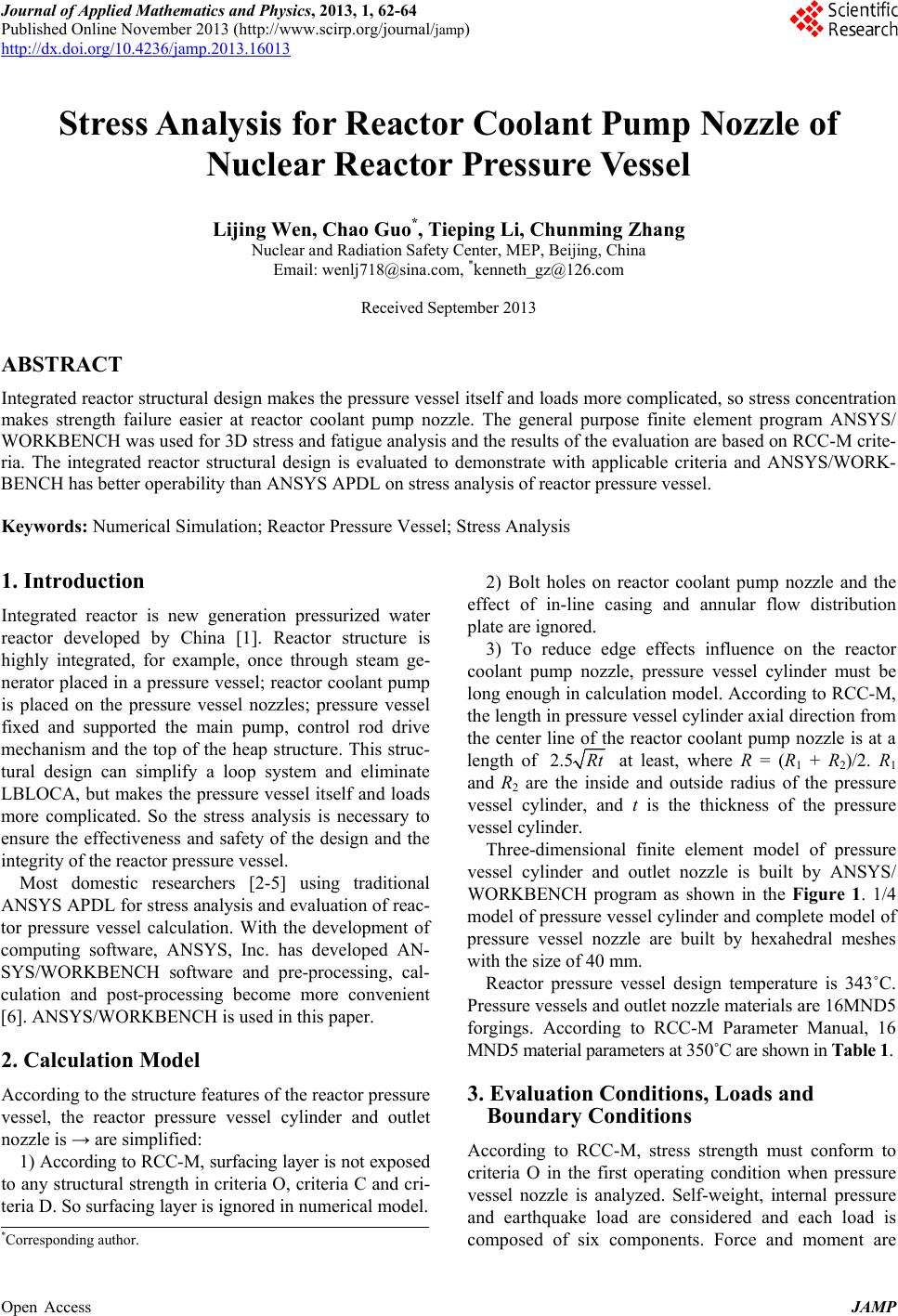
Journal of Applied Mathematics and Physics, 2013, 1, 62-64
Published Online November 2013 (http://www.scirp.org/journal/jamp)
http://dx.doi.org/10.4236/jamp.2013.16013
Open Access JAMP
Stress Analysis for Reactor Coolant Pump Nozzle of
Nuclear Reactor Pressure Vessel
Lijing Wen, Chao Guo*, Tieping Li, Chunming Zhang
Nuclear and Radiation Safety Center, MEP, Beijing, China
Email: wenlj718@sina.com, *kenneth_gz@126.com
Received September 2013
ABSTRACT
Integrated reactor structura l design makes the pressure vesse l itself and loads more complicated, so stress concentration
makes strength failure easier at reactor coolant pump nozzle. The general purpose finite element program ANSYS/
WORKBENCH was used for 3D stress and fatigue analysis and the results of the evaluation are based on RCC-M crite-
ria. The integrated reactor structural design is evaluated to demonstrate with applicable criteria and ANSYS/WORK-
BENCH has better operability than ANSYS APDL on stress analysis of reactor pressure vessel.
Keywords: Numerical Simulation; Reactor Pressure Vessel; Stress Analysis
1. Introduction
Integrated reactor is new generation pressurized water
reactor developed by China [1]. Reactor structure is
highly integrated, for example, once through steam ge-
nerator placed in a pressure vessel; reactor coolant pump
is placed on the pressure vessel nozzles; press ure vessel
fixed and supported the main pump, control rod drive
mechanism and the top of the h eap struc ture. This struc-
tural design can simplify a loop system and eliminate
LBLOCA, but makes the pressure vessel itself and load s
more complicated. So the stress analysis is necessary to
ensure the effectiveness and safety of the design and the
integrity of th e reactor pressure vessel.
Most domestic researchers [2-5] using traditional
ANSYS APDL for stress analysis and evaluation of reac-
tor pressure vessel calculation. With the development of
computing software, ANSYS, Inc. has developed AN-
SYS/WORKBENCH software and pre-processing, cal-
culation and post-processing become more convenient
[6]. ANSYS/WORKBENCH is used in this paper.
2. Calculation Model
According to the structure features of the reactor pressure
vessel, the reactor pressure vessel cylinder and outlet
nozzle is → are simplified:
1) According to RCC-M, surfacing layer is not exposed
to any structural strength in criteria O, criteria C and cri-
teria D. So surfacing layer is ignored in numerical model.
2) Bolt holes on reactor coolant pump nozzle and the
effect of in-line casing and annular flow distribution
plate are ignored.
3) To reduce edge effects influence on the reactor
coolant pump nozzle, pressure vessel cylinder must be
long enough in calculation model. According to RCC-M,
the length in pressure vessel cylinder axial direction from
the center line of the reactor coolant pump nozzle is at a
length of
at least, whe r e R = (R1 + R2)/2. R1
and R2 are the inside and outside radius of the pressure
vessel cylinder, and t is the thickness of the pressure
vessel cylinder.
Three-dimensional finite element model of pressure
vessel cylinder and outlet nozzle is built by ANSYS/
WORKBENCH program as shown in the Figure 1. 1 /4
model of pressure vessel cylinder and complete model of
pressure vessel nozzle are built by hexahedral meshes
with the size of 40 mm.
Reactor pressure vessel design temperature is 343˚C.
Pressure vessels and outlet nozzle materials are 16MND5
forgings. According to RCC-M Parameter Manual, 16
MND5 material parameters at 350˚C are shown in Table 1.
3. Evaluation Conditions, Loads and
Boundary Conditions
According to RCC-M, stress strength must conform to
criteria O in the first operating condition when pressure
vessel nozzle is analyzed. Self-weight, internal pressure
and earthquake load are considered and each load is
composed of six components. Force and moment are
*Corresponding a uthor.